We've now finished our month-long (actually 32-day) stay in DC, and it was wonderful. There is so much to see and do that we've already decided to return again for at least two weeks, and maybe even a whole month, some time in the not-too-distant future. Be forewarned, however, that there was so much we
did see and do in this month that this is the longest blog entry we've yet written.
The idea of spending time in DC arose the last time we were here and said to ourselves we really needed a month to see it all. Fairly quickly it rose to top position on our "bucket list" of things to do before we kick the bucket. We also put some thought into what time of year would be best. Having just now experienced mid-October to mid-November, we can't think of a better time. The foliage has been glowing with brilliant yellows and warm oranges almost everywhere we go, the thermometer has been hitting high 50s to mid 60s almost every day, and there's also an extra bit of energy in this town during election season.

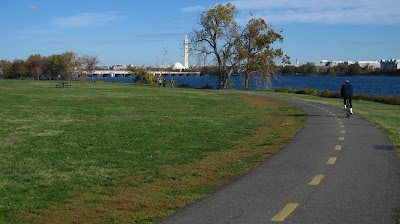
In our last blog entry we showed you our place and the street it's on, and above are two photos taken a few blocks away on our walk to the nearest Metro (subway) station, showing the high bridge Connecticut Ave. takes over Rock Creek when we first arrived and then about 2 weeks later. Half a mile from our place we could connect to the Rock Creek bike trail that took us down to the Potomac right next to the Kennedy Center. From there we were able to ride straight onto the Mt. Vernon Trail on the Virginia side, and follow the Potomac 20 miles downstream to George Washington's home. It's not a rail trail so it was a bit hilly and twisty in places, but it was a fun ride with one unexpected surprise when we passed under the flight path of planes coming in for a landing at Washington National Airport and felt like we could almost high-five the landing gear.


The day we chose to visit Mt. Vernon they were recovering from a lightning strike nearby that had cut power to the museum. We were offered either half-price admission for the day, or full-price admission with the right to come back another day. Well, given that it was a 43-mile round trip from our place that only left us a limited time for sightseeing once we got there, we opted for the second option. Good choice, as we stayed there each time 'til the last possible minute that would get us home before sunset. Of course we toured the house (no photos allowed inside, alas), but also roamed the grounds to see this last remaining slave cabin, and had a fascinating time visiting with "Lady Washington," who declared great astonishment to hear that there were new states further west than Virginia and Pennsylvania, and was quite flabbergasted to hear that one of these new states was named after her dear husband!



Washington is home to our good friends Louise and Masaharu, whom Louise has known for about forty years since she and they were all living in Tokyo. We did two walks with both of them and a few more just with Louise, as Masaharu was buried in work for a report summarizing his work analyzing the efficacy of foreign aid from groups like the IMF and World Bank in third world countries. The hikes the four of us did were west of DC in some Maryland county parks, including the shots here at Frank Lake shortly before we left, obviously at the tail end of the foliage season.

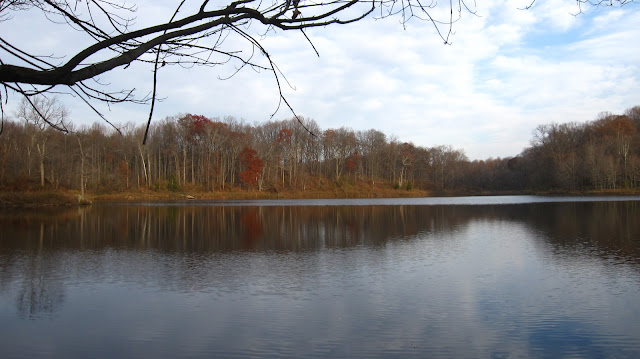
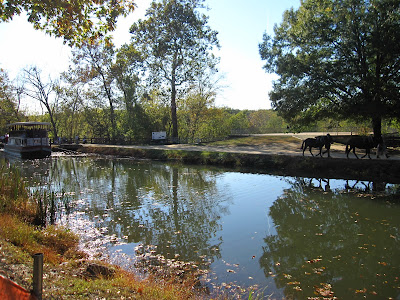
Earlier, we did two hikes with Louise and the two of us along the Potomac near Great Falls, a place where the Potomac drops 76 feet over a short stretch and the parallel C&O Canal goes through five or six locks. Although most of the canal is no longer maintained, they do keep a short stretch operable near the Great Falls Tavern, and run an authentic canal boat from April through October for a short trip back to the 19th century.


In the area between the canal and river are a series of loop trails called Billy Goat Trail A, B and C. Billy Goat A was the most scenic, such as this rocky promontory where we stopped for lunch, but the trail was
quite rugged. After more than enough rock scrambling and crawling across bridges, we were glad to be on the much less challenging other trails and the even tamer canal towpath, even if it involved meeting a snake or two.
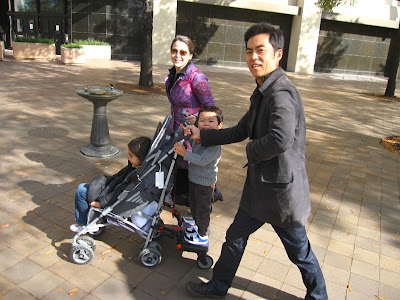
We also had a terrific visit from daughter Lisa, her husband Ray, and our darling grandkids Elise and Issei. They lived in the District for several years so were very happy to see some familiar places and explore a few new ones. Our apartment was around the corner from a playground where the little guys got to unleash some pent-up energy, and our place also had a nice sofa for story time with grandma or grandpa each evening. We visited the zoo one day and met up with friends of theirs and the friends' own impishly cute kids (the ones on the right of the photo), then spent another day visiting the Old Post Office and the National Museum of Natural History.




The Old Post Office is the third-tallest structure in DC after the Washington Monument and the top of the Capitol Building, and the easiest to get to the top of. We had virtually no wait to ascend via two elevators, and got a panoramic view of Washington and nearby parts of Maryland and Virginia. You can click on the photo below (or any other photo in the blog) to enlarge it and see the familiar icons of the capital, from the Lincoln to the Jefferson Memorials, with the red roofs of the federal triangle office buildings just below you. Elise was particularly excited when she recognized that the tiny little Lincoln Memorial off in the distance was that thing she had seen so many times on the back of pennies. We've heard since then that she still gets excited to look at the back of each new penny she sees to see the building she saw in Washington DC.

One last activity to discuss before we get to the many museums and other tourist sites -- we were surprised to find that DC has a less vibrant theater and music scene than Seattle. The only choice for theater was a revival of Hair at the Kennedy Center (South Pacific, which we would have happily gone to see, starts there in December). We could not find any other live theater worth mentioning.

As for music, we learned too late that you need to go to the individual web sites of each Smithsonian museum before you get to town and to each one's calendar of upcoming concerts and lectures. We missed a few good ones, though we did follow that advice with the Phillips Gallery and as a result were able to hear an outstanding Russian pianist perform Scriabin and Liszt in the music room there. We also went to hear the National Philharmonic Orchestra, not to be confused with the older and more prestigious National Symphony Orchestra but nonetheless an excellent group of musicians, perform in Strathmore Hall in Bethesda. This is a new hall a short walk from one of the suburban Metro stations, and it is quite beautiful indeed. They performed Dvorak's
Cello Concerto and his
New World Symphony. Our admiration for Antonin Dvorak reaches almost religious levels of adoration, and in fact we did a pilgrimage, by bike of course, to Spillville Iowa some years ago to see the town he spent the summer of 1893 in and to visit the place he called home while he composed the
American Quartet and polished up the
New World Symphony. We'll definitely do more planning the next time we come to town.

Our one other performing arts experience was Prokofiev's ballet
Romeo and Juliet at the Kennedy Center, which we thoroughly enjoyed. On leaving we found ourselves quite distracted. In the lobby they had an fascinating display using rice to illustrate all sorts of numbers. Each grain of rice represented one human in each of 30 or 40 displays of statistics, such as the number of centenarians in the US or the astonishingly large pile of rice representing the number of Americans without health care insurance. Some others shown below are the three piles representing Barack Obama addressing the crowd in Berlin, JFK in Berlin, and M. L. King giving his "I Have a Dream" speech in Washington (
note: look for the single grain of rice in each, representing the speaker); and finally the very tiny collection of rice grains representing every human who has walked on the moon. What a creative way to convey "dry" information!



Which is a wonderful segue into the rest of our time in DC. On three fourths of the days we spent there, our primary activity was of course visiting museums that made dry information come alive. The most moving, the Holocaust Museum, shall go without illustration here, partly because photos are not allowed, more importantly because the experience is far too visceral for any photo to do it justice. We spent an entire day absorbing it all, and as familiar as we are with the many of the facts of the Holocaust, it's quite another matter to experience it here. We came away feeling like the victims were real people, people we had come to know if only a little, people who were not mere statistics or grains of rice in the hourglass of time.
Another powerful exhibit was at the Renwick Gallery across the street from the White House, and called "The Art of Gaman," referring to the Japanese word for "putting up with something." This temporary exhibit showed us dozens of objects, some of great beauty, created by Japanese-Americans sent to the internment camps during WW II, and crafted with whatever they could scavenge from the camp environs. We could fill up the blog with dozens of examples, but this one wood carving will have to suffice to keep the blog manageable. Upstairs in the permanent exhibits were many other outstanding examples of crafts, the focus of the Renwick, including this whimsical wood sculpture entitled "Rejects from the Bat Factory."



Of course the various Smithsonian museums kept us busy for weeks. In what used to be the offices of the Patent Offices, the ostentation of which you can see below, the Smithsonian has created two museums under one roof, the National Portrait Gallery and the National Museum of American Art. We poked our heads into the portrait galleries thinking that a portrait collection would be boring, but the one-paragraph summaries of each person's life (and often the portraits as well) were compelling, even Alan Greenspan's, and we found ourselves as transfixed as we were by the rice statistics at the Kennedy Center.

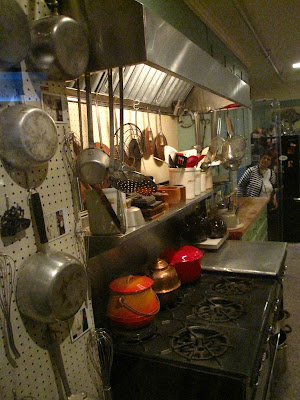
Another early stop was the National Museum of American History. We had been here before but still dropped in a few times for an hour or two each to see a variety of objects that form a part of our history as Americans, such as the original Kermit the Frog, Archie and Edith Bunker's favorite easy chairs, and Julia Child's kitchen, seen here from opposite corners of the room. This wasn't her studio kitchen, this was her
real kitchen, from her home, and the Smithsonian has kept it just as Julia Child left it, dishtowels and all.


Our apartment was convenient to the Metro as we noted above, and a short walk and brief ride past a few of its distinctive stations brought us to the National Museum of Natural History, the largest natural history collection in the world. As in New York, we were drawn to the exhibits about human evolution, very nicely summarized in the timeline and the human family tree reproduced below. One of the more interesting hands-on exhibits was called "MEanderthal," which you yourself can download to an Android or Apple smartphone from the museum's website. The third photo below is Jeff as a
homo floresiensis, a cousin as it were to Neanderthals and to modern humans.
We also enjoyed the halls of mammals, some quite unusual such as this Chinese Water Deer with tusk-like canine teeth, and the hall of skeletons that show how similar we are to our primate cousins.
It's hard to stay indoors a lot when the weather is as fine as it was most days we were in DC, so we did a lot of walking as well. Some days, that involved walking one way to the museums on the Mall, about three miles, and other days we just wandered about the Mall past the many monuments and memorials, such as the dynamic Korean War Memorial and the Vietnam War Memorial, which we visited on Veterans' Day while a special ceremony was being held there.


A fairly new addition to the Mall, and one we had not previously seen, is the World War II Memorial. It consists of a central fountain and simple granite panels with the names of major theaters of war, with an entryway that is lined with brass bas reliefs of scenes from the war, such as this family listening around the radio to FDR's War Message to Congress; factory workers in a defense plant; and airmen parachuting into one of those theaters of war. We felt the memorial did a good job of being dramatic and monumental, and at the same time bringing in the personal and heroic aspects of the war.





Another day when it was too nice to stay inside for long, we walked from our place to the National Cathedral. For a country with a policy of separation of church and state, this is as close as you can get to a "national" church, and indeed it has been the site of important national events such as President Kennedy's funeral. We took this view of the nave from a point about one third of the way in from the front door to the far end, and there is still a lot of church before us. To the side were fascinating windows, each with a story. The first below is the War and Peace Window, appropriately enough in the nook above the sarcophagus holding the body of Woodrow Wilson. Nearby is the Space Window, which actually contains a piece of moon rock brought back by astronauts on the Apollo XI Mission!
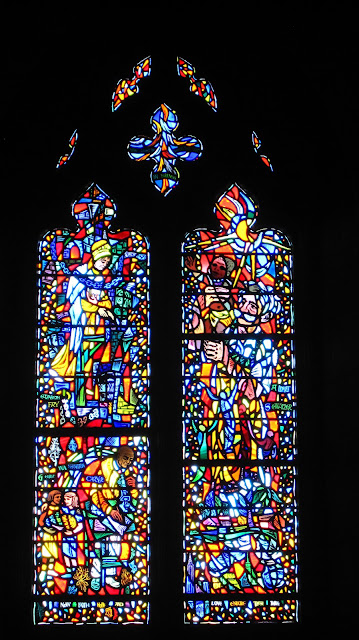
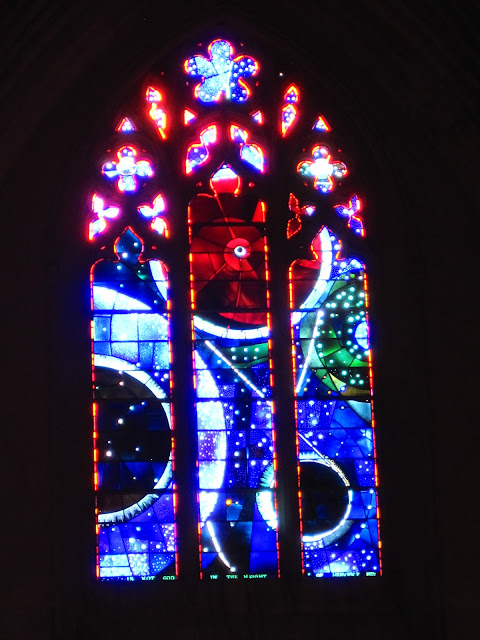
While we skipped the Air and Space Museum on this trip, we did visit a few interesting Smithsonian museums near it. One was the quite small Freer Gallery, which focuses on asian art and a few American paintings influenced by it, particularly those of James McNeill Whistler. Two items that caught our attention were this scroll painting from 1347 by Zhao Yong entitled Horse and Groom, and a 1909 painting by Childe Hassam called The Chinese Merchants, showing a scene in downtown Portland Oregon. The frame was custom-designed by Hassam for this painting.


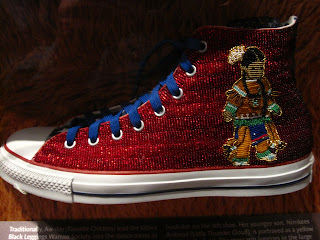
Just the other side of Air and Space from the Freer is one of Washington's newest museums, the National Museum of the American Indian. Almost all of the curatorship of the the museum is by Native Americans from the US, Canada and the rest of the Americas, and the museum had a good blend of items and commentary that ranged from, "Wow, look at that" to "Hmmm, do I agree with that . . .," and an occasional item to just make you smile like this pair of photos dealing with beads. The following two photos you might want to enlarge and read, as they were both good examples of the interesting and provocative side of the museum.



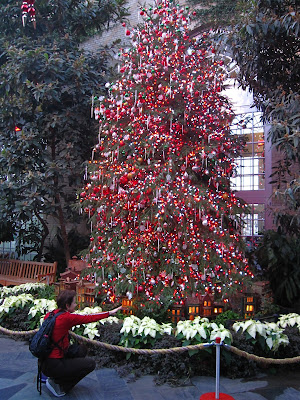
Right between the American Indian Museum and the Capitol is the National Botanic Garden and its conservatory, which is reminiscent of conservatories in Volunteer Park in Seattle and Golden Gate Park in San Francisco, but larger than the two of them combined and, for reasons we couldn't quite articulate, twice as nice. Perhaps you'll see something in these photos to give you, and us, a clue. By the way, the close-up is of poinsettas and a flower new to us, named "Cat's Whiskers." Sort of fits, doesn't it?


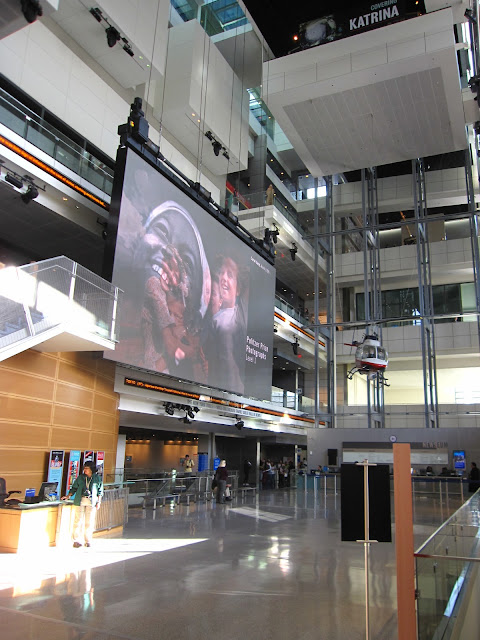
Another newcomer to the museum scene in DC is the "Newseum," a museum dedicated to the news business and the First Amendment. Tickets are good for two consecutive days, and we spent the better part of two days absorbing as much as we could. Exhibits ranged from a collection of every Pulitzer-Prize-winning photo since the award began to films discussing ethical dilemmas in news reporting. There were thoughtful discussions of First Amendment issues, with a few light sides like the Simpson's cartoon below, and a hall displaying examples of news reporting over the centuries, including a pamphlet containing news about the Salem Witch Trials.
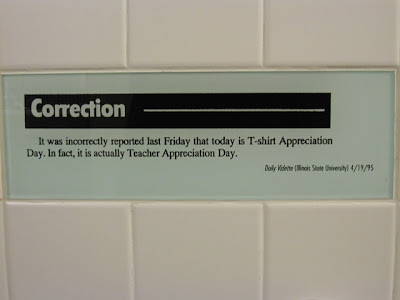
All the guide books alert their readers that they should be sure to check out the killer view from the outside balcony, and it did not disappoint. They failed, however, to alert us to the bathrooms, which contained tiles with examples of actual headlines and correction notices from newspapers whose editors, just possibly, failed to drink enough coffee on those days. In addition to the one illustrated here, others that tickled were "Crack in Toilet Bowl Leads to 3 Arrests;" "Never Withhold Herpes Infection From Loved One;" "Woman Found Dead in Trunk of Car Kept to Herself, Neighbors Say;" "Police Oversight Group Likes San Jose Model;" "Robber Holds Up Albert's Hosiery;" and our favorite, "Deer Kill 130,000."

Which brings us finally to the various art museums we visited. We began this trip with a stop at the Toledo Museum of Art, and perhaps for the first time had truly animated discussions together about paintings. It was a terrific collection, even by Washington DC standards. DC has two first-rate private collections, the Corcoran and the Phillips, plus one of the world's great art museums, the National Gallery of Art, as well as the art museums we've already mentioned above.

The Corcoran is a bit pricey but is free every Thursday evening. Perhaps because of his background growing up in the heart of New York City, Jeff has always admired the rough "Ashcan School" style of Reginald Marsh, and his
Smoke Hounds, set in the Bowery in 1934, is a good example. Having visited the homes of Thomas Cole and Frederick Church this summer, we are always eager to see their paintings. The Corcoran had a few, including
The Return, part of a two-painting set done in 1837 by Cole. In this second half of the pair, the lord who left on a battle campaign in the first painting is being brought back not triumphant, but dead. Isn't the lighting marvelous? In Church's
Tamaca Palms, done in 1854 and reworked in 1877, you can see the drama that he brought to landscape painting.
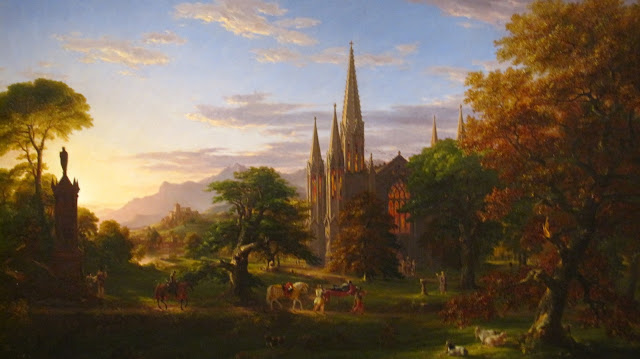

One last painting at the Corcoran deserves mention, Samuel F. B. Morse's scene of a night session in the House of Representatives. He painted it in 1822, spending ages getting each person portrayed accurately, then put it on exhibition. It was a flop, and was eventually sold for much less than he thought it deserved. With his painting career seemingly going nowhere, he spent more and more time tinkering with a little device that made short and long sounds using electricity, and the rest, as they say, is history. Ironically, historians love this painting today as one of the best portrayals of politics from the Jacksonian period.
The other great private art museum is the Phillips, and it contains one of the most well-known paintings in the world, The Luncheon of the Boating Party that Auguste Renoir painted in 1881.
The Phillips is more than just this painting, of course, and we found much to admire, including Vincent Van Gogh's 1889 The Road Menders, and J. M. W. Turner's 1841 sun-drenched View of Venice. Interestingly, we got to see a number of works from the Oberlin Museum of Art on loan to the Phillips while the college renovates its own facilities, helping make up for our disappointment when we passed through Oberlin last summer and found the museum shuttered.



Well, that leaves the best for last, the National Gallery of Art. We loved it so much, we came back to galleries we'd already lingered in, to see our favorite paintings once again. We also took advantage of some of the gallery talks, such as this first one where our guide is discussing Mary Cassatt's 1882 painting,
The Loge, and helping us appreciate the careful composition that went into what at first glance looks like a casual view of two young women at a concert. Another gallery talk was about self-portraits, and our docent helped us see that in 1630 when she painted herself, Judith Leyster didn't actually wear the outfit she portrays herself in while painting, but rather used the clothing in the painting to impress on potential clients that (1) she had the ability to paint fine clothing in a realistic and flattering way, and (2) she was wealthy enough to afford such clothing, implying a lot of satisfied customers.


Here are just a few more of our favorites: a charming 1877 painting by James Tissot called, for obvious reasons,
Hide and Seek; Rembrandt van Rijn's chiaroscuro masterpiece from 1658,
Philemon and Baucis, and Pieter de Hooch's charming
The Bedroom done two years later; two Hudson River School paintings of places we've seen on recent bike trips, Thomas Cole's 1839
Crawford Notch and Jasper Cropsey's 1860
Autumn on the Hudson River; and Albert Bierstadt's monumental painting done in 1858,
Lake Lucerne.




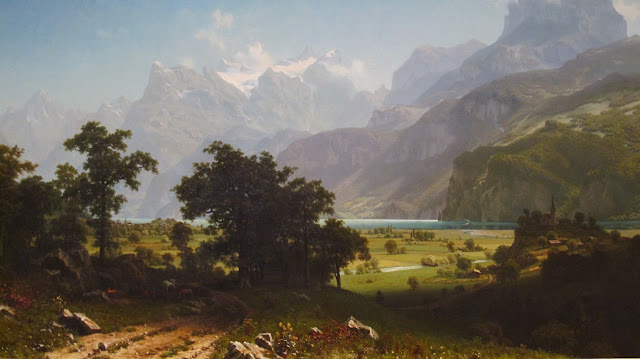

As large as the National Gallery of Art is, they began to run out of space a few decades ago and commissioned architect I. M. Pei to design what became know as the East Wing. Louise's brother Richard actually worked on part of the design and was the supervising architect on site during construction, and it is a marvelous building. It's across the street from the main building, but an underground walkway with a moving sidewalk connects the two. The East Wing is used mainly for the museum's contemporary art, however, not an area we're particularly drawn to, though we
were amused by the wry humor in Rene Magritte's 1933 work,
La Conditione Humaine (hint: look at it
very carefully). More our speed was an 1890 pointillist work by Camille Pissarro of the
Charing Cross Bridge.

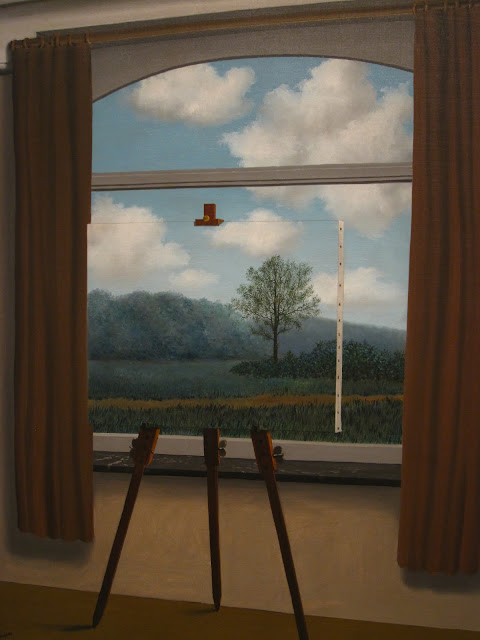

Well, the month was finally up and, with help from our dear friend Louise, we got ourselves, all our luggage, and our tandem bike to Union Station, where we enjoyed one last meal with her. We're now on our way via Amtrak to Austin Texas to see Jeff's daughter Rebecca and her family, then on to Santa Monica California to spend a month near Louise's son Brian and his family. Tell you -- -- and show you -- more soon!
 We just had to wonder, how many tourists do they have to fish out of the river each year, given those unfenced walkways? It appears that the river is healthy, given the birds like the lone snowy egret or the trio of cormorants that hang out along the river, and one more that we saw with a catch about to become a meal.
We just had to wonder, how many tourists do they have to fish out of the river each year, given those unfenced walkways? It appears that the river is healthy, given the birds like the lone snowy egret or the trio of cormorants that hang out along the river, and one more that we saw with a catch about to become a meal.

